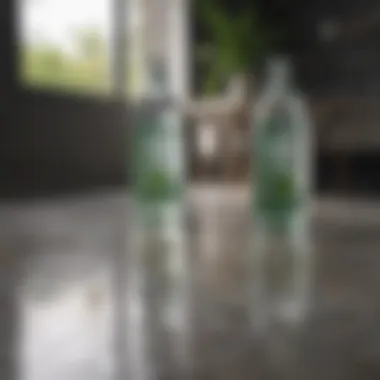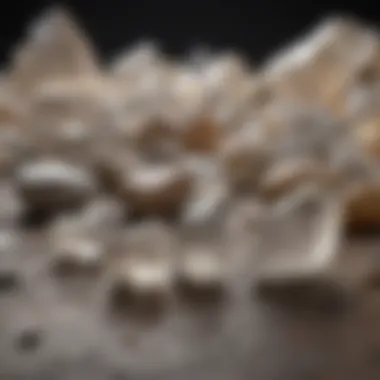Ultimate Guide to Cleaning Quartz Surfaces Effectively


Intro
Cleaning quartz surfaces requires a thoughtful approach. Quartz, known for its durability and aesthetic appeal, is becoming a popular choice for countertops and other fixtures. Yet, maintaining its shine and quality can be challenging for homeowners. This section aims to provide an overview of effective cleaning methods tailored to different types of contaminants and usage scenarios.
Understanding the chemistry behind quartz can greatly aid in its care. Quartz surfaces are typically engineered with resins and pigments, making them resistant but not impervious. From grease marks to stains, quartz can accumulate various types of dirt. The methods used to clean these surfaces are critical, as using the wrong agents may damage the resin or alter the color.
Homes, especially those with heavy foot traffic, often experience wear and tear on their surfaces. Thus, knowing how to clean quartz properly is essential not just for aesthetics but for longevity. Different cleaning agents, tools, and techniques will be examined in detail to arm homeowners with the knowledge they need.
Key Points
- Understanding quartz surface composition is vital.
- Different contaminants require varied cleaning methods.
- Best practices in quartz care enhance durability.
By exploring these aspects, we can ensure that quartz surfaces retain their luster while remaining functional and beautiful.
Design Inspiration
While this article primarily focuses on cleaning quartz surfaces, understanding design inspirations can also influence choices in maintaining those surfaces. Here are some insights into trending styles and color palettes that may apply to your quartz installations.
Trending Styles
The popularity of quartz is linked to its versatility in design. Many homeowners favor clean lines and minimalistic designs, often combined with natural elements. Matte finishes, for example, are trending, lending a contemporary touch.
- Minimalistic: Focus on simplicity, highlighting tranquility and space.
- Rustic: Incorporate textures that emulate nature, making quartz feel more organic.
- Industrial: Dark and moody tones with a slight gloss emphasize modern aesthetics.
Color Palettes
Color selection plays a significant role in how quartz surfaces are perceived in space. Popular color choices include:
- Whites and Off-Whites: Provide a fresh and clean look suitable for any environment.
- Greys: Offer a sleek appearance, often paired seamlessly with modern fixtures.
- Bold Hues: Colors such as deep blue or rich burgundy provide striking contrast and can act as focal points.
These design elements not only cater to personal taste but also contribute to the overall maintenance strategy by enabling better compatibility with cleaning methods.
Practical Tips
Implementing effective cleaning strategies for quartz surfaces involves a few crucial practices. Here are some practical tips to keep quartz pristine.
Maintenance & Care
Regular maintenance is key. Here are steps homeowners can take:
- Wipe spills immediately to avoid stains.
- Use a soft cloth or sponge with warm soapy water for daily cleaning.
- Avoid abrasive cleaners as they can scratch the surface.
- For tougher stains, specially formulated quartz cleaners can be effective.
Regular maintenance prevents the buildup of grime, which can make cleaning more difficult.
Budgeting & Planning
Cleaning quartz surfaces can be budget-friendly with some planning. Factors to consider include:
- Cleaning Supplies: High-quality cleaning solutions may seem costly, but they often last longer and are more effective.
- Time Investment: Setting aside time for regular cleaning can save costs on professional services later.
- Preventative Strategies: Investing in cutting boards and coasters can protect the surface from scratches and heat.
A calculated approach towards budgeting for cleaning can preserve both quartz surfaces and finances.
Understanding Quartz
Understanding quartz is crucial for anyone looking to maintain its surfaces effectively. Quartz is not just a popular choice for countertops and interiors, but it also presents unique characteristics that influence cleaning methods and long-term care. Recognizing these properties enables homeowners and design enthusiasts to make informed choices that preserve the material's aesthetic and functional qualities. From its durability to its non-porous nature, knowing about quartz helps in developing suitable cleaning strategies and avoids pitfalls that could lead to irreversible damage.
Properties of Quartz


Quartz is primarily composed of silicon dioxide, making it hard and incredibly resilient. This durability contributes to its widespread use in various applications, especially in kitchens and bathrooms. The non-porous quality of quartz surfaces resists staining, which is advantageous when dealing with food and beverage spills. Unlike natural stones, quartz does not require sealing, as it is inherently resistant to moisture and bacteria. This characteristic also simplifies the cleaning process, allowing for easy maintenance with the right cleaning agents.
Moreover, quartz surfaces come in a vast range of colors and patterns, driven by the blending of natural minerals. This aesthetic versatility allows homeowners to achieve their desired interior design without sacrificing functionality. In terms of thermal resistance, quartz can withstand moderate heat and is somewhat resistant to scratches, although extreme heat and sharp objects should still be avoided.
Applications of Quartz in Interiors
The applications of quartz in interior settings are numerous, primarily due to its favorable properties. Commonly seen in kitchens as countertops, quartz also finds its place in bathroom vanity tops and flooring. Notably, quartz surfaces are popular in commercial spaces where durability and aesthetics are crucial.
Other applications include backlit quartz installations, which become exquisite focal points in modern design. Additionally, quartz composite materials are frequently utilized in sinks and islands, offering both bold design and practical use. The adaptability and resilience of quartz make it a favorite not only for homeowners but also for interior designers looking to blend style with longevity.
"Quartz surfaces combine beauty with function, making them an ideal choice for any interior space."
Understanding the properties and applications of quartz enriches one's knowledge on how to care for it effectively, establishing a solid foundation for the comprehensive cleaning methods discussed later in the article.
Common Contaminants on Quartz
Understanding common contaminants on quartz surfaces is essential to maintaining their aesthetic appeal and longevity. Quartz countertops, commonly found in kitchens and bathrooms, are exposed to various substances daily. Recognizing these contaminants can help homeowners take appropriate measures for effective cleaning and care.
Types of Stains
Stains on quartz surfaces can originate from numerous sources, often leaving behind unsightly marks that affect their visual appeal. Here are the main types:
Food and Beverage Stains
Food and beverage stains often result from spills that occur during meal preparation or consumption. These stains can vary widely in color and intensity depending on the substance. Common culprits include red wine, coffee, and sauces. These stains are important to recognize as they contribute to the overall appearance of the surface. Immediate attention to these stains can prevent them from setting in. A key characteristic of food and beverage stains is that they are usually easy to clean with the right approach. While some may fear deep staining, quartz is relatively non-porous, providing a significant advantage. However, relying solely on quick fixes might lead to potential disadvantages, such as prolonged staining or damage to the surface if harsh chemicals are used.
Oils and Greases
Oils and greases present a different challenge for quartz surfaces. These contaminants are typically left behind from cooking or food preparation, often creating slippery patches. The sticky nature of greases allows them to adhere firmly to the surface, making them challenging to remove. A primary characteristic of these stains is their ability to deepen if not addressed promptly. This type of stain can be detrimental to the surface as it may require stronger cleaning solutions, which could ultimately harm the quartz finish. Awareness of this aspect highlights the importance of preventative care and cleaning immediately after spills.
Water Marks
Water marks are often seen on quartz surfaces, particularly in areas with high moisture, like kitchen sinks. These marks arise from mineral deposits left by evaporating water. Even though they may seem harmless, water marks detract from the shine of the quartz. One of their key characteristics is that they are usually subtle yet persistent. Addressing water marks early can prevent further mineral buildup, which could lead to discoloration. One advantage of quartz is that it is relatively easy to restore its shine when dealing with water marks, provided that appropriate cleaning agents are utilized.
Accumulation of Dirt and Dust
Apart from stains, dirt and dust accumulation can significantly diminish the appearance of quartz surfaces. Even in well-maintained homes, these particles can settle and form a layer that dulls the shine of the quartz. Regular cleaning to remove dirt and dust is crucial. Allowing these particles to stay on the surface may lead to an environment that absorbs moisture, potentially encouraging bacteria growth over time. Keeping surfaces free from dirt supports not just the aesthetic value but also aids in maintaining hygiene. In reality, regular and minimal maintenance can help prevent troublesome cleaning sessions in the future.
Suitable Cleaning Agents for Quartz
Selecting the right cleaning agents for quartz surfaces is essential for maintaining their pristine appearance and durability. Quartz is a non-porous material, meaning it resists stains and spills better than many other surfaces. Yet, improper cleaning methods can lead to surface damage or reduce its luster. This section will explore various cleaning agents that are not only effective but also safe for quartz surfaces.
pH-Neutral Cleaners
pH-neutral cleaners are among the most recommended products for cleaning quartz. These solutions maintain a balance that is neither acidic nor alkaline, thus preventing any potential damage to the quartz surface. When using a pH-neutral cleaner, homeowners can be assured that their countertops will remain free from etching and dullness.
A significant benefit of pH-neutral cleaners is that they are versatile. They can effectively remove everyday spills like juice or coffee without causing harm to the surface. Regular use of these cleaners contributes to the longevity of the quartz while also preserving its shine.
Advantages of pH-Neutral Cleaners:
- Gentle on Surfaces: Safe to use daily without risking damage.
- Effective Cleaning: Removes common stains and dirt.
- Non-Toxic: Safe for household use, especially in homes with children and pets.
Alcohol-Based Cleaners
Alcohol-based cleaners are another effective option for cleaning quartz surfaces. They are particularly useful in dissolving oils and grease that can accumulate over time. Using these cleaners requires caution, as they can be slightly harsher than pH-neutral ones. However, the quick evaporation rate of alcohol means that residues are less likely to remain on the surface.
It is crucial to choose an alcohol-based cleaner that does not contain abrasive ingredients. A soft microfiber cloth can be used with these cleaners to achieve a clean finish without scratching the quartz.


Benefits of Alcohol-Based Cleaners:
- Fast Evaporation: Reduces the risk of streaks.
- Efficient Grease Removal: Targeted for stubborn oily spots.
- Widely Available: Can be found in many grocery and cleaning supply stores.
Homemade Cleaning Solutions
For those who prefer natural cleaning methods, homemade solutions are a practical alternative. A simple mixture of warm water and mild dish soap can effectively clean quartz surfaces. This option allows homeowners to avoid chemicals often found in commercial products. Other popular ingredients include vinegar and baking soda, but caution is recommended as vinegar is acidic and should not be used frequently on quartz.
Simple Homemade Cleaner Recipe:
- Mix one tablespoon of mild dish soap with warm water in a spray bottle.
- Spray the solution onto the quartz surface.
- Wipe with a soft cloth or sponge, ensuring all residues are cleaned off.
Step-by-Step Cleaning Techniques
Cleaning quartz surfaces effectively requires a methodical approach. This section highlights essential techniques that ensure longevity and maintain the appearance of quartz materials. Establishing a routine cleaning procedure can significantly enhance the durability of quartz surfaces. It helps prevent stains and the buildup of grime, ensuring your surfaces look their best.
Daily Cleaning Procedure
A consistent daily cleaning routine is crucial for quartz. After each use, wipe down the surface with a soft cloth and warm water. This simple act removes spills before they settle in and prevents staining. For a more thorough clean, use a pH-neutral cleaner specifically designed for quartz. This ensures that you do not damage the surface while effectively eliminating dirt and maintaining its shine. Here’s a quick list for daily cleaning:
- Gather a soft cloth and a spray bottle with a pH-neutral cleaner.
- Lightly spray the cleaner on the quartz surface.
- Wipe the area with the cloth, applying gentle pressure.
- Rinse the cloth and wipe down again with clean water to remove any residue.
Removing Stubborn Stains
Some stains may require extra effort to clean. Food or beverage spills, if not addressed promptly, can leave marks that resist regular cleaning methods. Common stubborn stains include those from coffee, wine, or tomato sauce. Use a mixture of warm water and a few drops of dish soap to create an effective stain remover. For tougher stains, a paste of baking soda and water can work wonders. Apply the paste, let it sit for a few minutes, and then gently scrub with a soft cloth. Avoid using abrasive scrubbers, as they can scratch the surface. Here’s a concise method:
- Identify the stain and prepare the cleaning solution or paste.
- Apply the solution to the stained area.
- Let it sit to penetrate the stain.
- Gently scrub and rinse with clean water.
- Repeat if necessary.
Cleaning Products to Avoid
While there are many cleaning agents suitable for quartz, several products must be avoided to maintain the integrity of the surface. It’s essential to steer clear of:
- Harsh alkaline cleaners: These can break down the resin that binds quartz particles.
- Bleach-based products: They can cause discoloration and damage to the finish.
- Abrasive cleaners and pads: These can scratch and dull the surface.
- Vinegar and lemon juice: Their acidity can harm the surface over time.
Choosing the right cleaning products is just as important as having a good cleaning technique.
These steps provide a thorough understanding of how to maintain quartz surfaces properly. Following these procedures will ensure your quartz remains beautiful and functional throughout its lifespan.
Preventative Care for Quartz Surfaces
Preventative care is essential for maintaining the pristine condition of quartz surfaces. By implementing effective measures, homeowners can significantly reduce the likelihood of stains and damage. Preventative strategies not only enhance the longevity of your quartz surface but also preserve its aesthetic appeal. Such care creates a barrier against deterioration and minimizes the time needed for future maintenance. It's beneficial for those who wish to enjoy their quartz without the stress of extensive upkeep.
Sealing Quartz Countertops
Sealing quartz countertops is a recommended practice to protect the surface from potential stains and bacteria. Although quartz is generally resistant to staining due to its non-porous nature, an additional sealant can offer extra security. Applying a sealer acts as a protective layer, providing an added defense against spills from common household items such as wine, coffee, and sauces.
It is advisable to choose a high-quality sealer that is appropriate for quartz. Typically, sealers can last anywhere from six months to a year before needing reapplication. Homeowners should check the manufacturer's recommendations to ensure compatibility with their specific quartz surface. A well-sealed countertop can also enhance the overall gloss and luster, making it visually appealing.
Using Mats and Trivets
The strategic use of mats and trivets plays a crucial role in preventative care for quartz surfaces. These items serve as effective barriers against heat and scratches. When placing hot cookware directly on quartz, the risk of damaging the surface increases. To prevent thermal shock, using trivets or heat-resistant pads is vital. This helps in maintaining the structural integrity and preventing unsightly marks.
Furthermore, mats can help absorb spills and catch crumbs, reducing the need for frequent cleaning. When selecting mats or trivets, choose products that are non-abrasive to avoid scratches. In addition, ensure that they are easy to clean to maintain hygiene. Incorporating these simple objects into your kitchen or dining area can extend the life of your quartz surfaces significantly.
"Preventative care simplifies maintenance. Small steps today can save time and effort in the future."
By focusing on these preventative measures, homeowners can protect their investment in quartz surfaces, enhancing both functionality and appearance.


Long-term Maintenance Considerations
Long-term maintenance of quartz surfaces is essential for preserving their appearance and functionality over time. Unlike natural stones, quartz surfaces, which are engineered and made from a combination of natural quartz crystals and resins, need careful handling to maintain their unique aesthetic. Regular care not only keeps the surfaces looking pristine but also extends their lifespan. Failure to implement a good maintenance routine can lead to more serious issues, like irreversible damage and the need for costly repairs.
Regular Inspection and Care
Regular inspection of quartz surfaces is critical in identifying signs of wear and tear before they become problematic. This should involve checking for visible cracks, chips, or discolorations regularly. Additionally, homeowners should examine the seams and edges to ensure they remain intact. The importance of such inspections cannot be overstated; early intervention can save significant costs down the line. It is advisable to clean the quartz surfaces frequently using pH-neutral cleaners. Doing so helps in assessing any potential damage while ensuring that stains do not set in.
Consider the following steps for effective regular inspections and care:
- Daily Wipe Down: Use a damp cloth to remove dust and spills promptly.
- Monthly Deep Clean: Apply a pH-neutral or alcohol-based cleaner for deeper maintenance.
- Bi-annual Checks: Look for any signs of scratches, and if present, take notes on their severity.
- Professional Evaluation: Every 1-2 years, consider a professional inspection for thorough maintenance advice.
By following these practices, one can implement a systematic approach towards maintaining quartz surfaces.
Dealing with Scratches and Chips
Scratches and chips on quartz surfaces, while less common due to their durability, can still occur, especially in high-traffic areas. Understanding how to address these issues is crucial for homeowners who value their quartz surfaces. Minor scratches can often be minimized or concealed using specific accessories like polishing compounds or waxes. However, deeper scratches or chips might require a more intensive approach.
Here are several methods to address scratches and chips effectively:
- For Minor Scratches:
- For Deeper Scratches:
- Seek Professional Help: If the damage is extensive or persists, finding a qualified professional becomes imperative. They can provide proper restoration techniques and ensure the integrity of the quartz surface is maintained.
- Clean the area with a pH-neutral cleaner.
- Apply a countertop polish or a specialized quartz cleaner to mask the scratch.
- Consider using fine-grit sandpaper to lightly buff the area, followed by a polish to restore shine.
- For chips, you may need epoxy resin tailored for quartz to fill gaps. This should be done with care to match the surface’s color and texture.
When to Seek Professional Help
When dealing with quartz surfaces, there are moments when professional assistance becomes not just advisable but necessary. Homeowners and anyone using quartz in their spaces should be aware of how and when to seek expert care. Not addressing certain issues can lead to long-term damage and higher repair costs.
Identifying Severe Damage
Recognizing severe damage on quartz surfaces is crucial. Some signs are more obvious than others. Here are some indicators that a professional inspection is needed:
- Deep scratches: If the surface has scratches that cannot be removed with regular cleaning or home remedies, it may need refinishing or professional polishing.
- Cracks or chips: Any visible crack or chip on the surface can affect the integrity of the quartz. Leaks or moisture can enter through these gaps, leading to further damage.
- Stains that persist: If stains remain after following best cleaning practices, this could indicate degradation of the surface that requires expert intervention.
- Uneven surfaces: If the quartz has started to sink or lift, this can indicate an underlying issue that only specialists can diagnose.
Finding Qualified Professionals
Once damage is identified, the next step is finding the right professional. A few key considerations will help in this process:
- Experience: Look for professionals who have significant experience specifically with quartz surfaces. Ask about their history and check reviews.
- Certifications: Check if the service provider holds relevant certifications or affiliations with recognized industry standards. These usually suggest reliable practices.
- Portfolio: Request to see examples of previous work. This can provide insights into their skill level and the quality of their finishes.
- Referrals: Ask friends or family for recommendations based on their experiences.
Seeking professional help is not a sign of weakness; it is a practical approach to maintaining your quartz surfaces.
By focusing on these aspects, homeowners can ensure they protect their investment while achieving the desired aesthetic and functionality for their quartz surfaces.
End
The conclusion serves as a vital element in consolidating the key aspects of maintaining quartz surfaces. As this article detailed, cleaning and caring for quartz is not just about aesthetics; it is about preserving the durability and integrity of the material. Regular care ensures that surfaces retain their luster and functionality over time.
Emphasizing best cleaning practices, homeowners can minimize stubborn stains and common tarnish while enhancing the longevity of their quartz. The knowledge shared here equips readers with systematic approaches to routine cleaning as well as deeper maintenance strategies. For instance, knowing the importance of sealing quartz countertops can prevent the accumulation of contaminants, leading to significant long-term benefits.
Moreover, recognizing when to seek professional assistance is essential. Professionals possess tools, technologies, and experience that can restore quartz surfaces effectively when the damage exceeds typical cleaning methods.
To summarize, the importance of maintaining quartz surfaces is twofold: ensuring aesthetic appeal and prolonging life span. These considerations provide a roadmap for homeowners, interior design enthusiasts, and party hosts alike in keeping their quartz surfaces beautiful and resilient throughout their usage.
Recap of Best Practices
In closing, here are the essential best practices highlighted throughout this article:
- Daily Cleaning Routine: Use a pH-neutral cleaner to wipe down surfaces regularly.
- Quick Stain Removal: Address spills promptly to prevent stains from setting.
- Avoid Harsh Chemicals: Steer clear of bleach or acidic cleaners that could damage quartz.
- Preventive Measures: Utilize coasters, trivets, and mats to protect the surface from heat and scratches.
- Periodic Inspection: Regularly inspect for signs of wear and seek repairs early to prevent more serious damage.
"Proper care and maintenance of quartz surfaces not only enhances beauty but also ensures functionality for years to come."
By integrating these best practices into your cleaning regimen, your quartz surfaces can shine brightly and stand the test of time.















